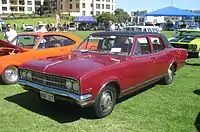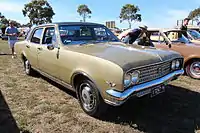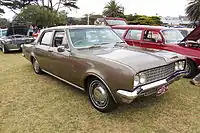| Holden Brougham | |
|---|---|
 | |
| Overview | |
| Manufacturer | Holden (General Motors) |
| Production | 1968–1971 |
| Body and chassis | |
| Class | Full-size luxury car |
| Body style | 4-door sedan |
| Layout | FR layout |
| Related | Holden Premier Chevrolet Constantia |
| Powertrain | |
| Engine | 4,093 cc Chevrolet 250 I6 (ZA) 5,025 cc Chevrolet 307 V8[1] 5,042 cc GMH 308 V8 |
| Transmission | 2-speed Powerglide automatic (HK, HT)[1] 3-speed Tri-Matic automatic (HT (May 1970 onwards), HG)[2][3] |
| Dimensions | |
| Wheelbase | 111.5 in (2,832 mm)[1] |
| Length | 192 in (4,877 mm)[1] |
| Width | 71.4 in (1,814 mm)[1] |
| Height | 56 in (1,422 mm)[1] |
| Curb weight | 3,097 lb (1,405 kg)[1] |
| Chronology | |
| Predecessor | Pontiac Parisienne |
| Successor | Statesman |
The Holden Brougham is a large, luxury automobile that was produced by Holden in Australia between July 1968 and 1971.
It was based on the mainstream Holden Premier of the same years, but with a lengthened rear body. The boot was simply extended by 8 inches (200 mm) rather than increasing the 111-inch (2,800 mm) wheelbase.[4] The Premier's four-headlight grille was also kept. The model was a hasty response to Ford Australia's successful Fairlane.
History
The HK series Brougham was launched in July 1968 along with the new Monaro coupés, six months after the HK Series Holden Belmont/Kingswood/Premier models. The Brougham then followed the model cycles of these mainstream Holdens: the HT series was announced in July 1969 and the HG series in August 1970.
Because of its luxury positioning, the Brougham was only available with an automatic transmission, first a two-speed, then a three-speed after the HG's launch. The only engine available in the original HK Series Brougham was a Chevrolet 307-cubic-inch (5.0 L) V8.[4] The HT series was launched with the new Holden designed and built 308 cubic inch V8, and was the first Holden to be powered by this engine (the rest of the HT range got the 307 until the 308 was made available across the HT range in September 1969). The 308 was carried over to the HG Series Brougham.[5]
Throughout its production life the Ford Fairlane outsold it by a large margin. The Brougham was replaced by the long-wheelbase Statesman models in 1971, on the redesigned HQ platform.[6]
South Africa
From 1969 to 1971 the Brougham was marketed in South Africa as the Chevrolet Constantia.[7] In addition to the name change, the Constantia featured a unique grille and had trafficators on the leading edge of the front fenders (as did its little sister, the Chevrolet Kommando).[7] It utilised a 250 cid (4,093 cc) Chevrolet inline-six or, as an option, Chevrolet's 307 cu in (5,025 cc) small block V8.[8] Either engine version came equipped with the two-speed "Powerglide" automatic transmission.[8]
Gallery
 1968–1969 Holden HK Brougham
1968–1969 Holden HK Brougham 1968–1969 Holden HK Brougham
1968–1969 Holden HK Brougham 1969-1970 Holden HT Brougham
1969-1970 Holden HT Brougham 1970-1971 Holden HG Brougham
1970-1971 Holden HG Brougham
Notes
- 1 2 3 4 5 6 7 Garnier (1969). "Australian luxury saloon powered by American vee-8 engine. Very smooth two speed automatic and good performance. Over sensitive, low-geared power steering. Excellent brakes. Reasonable ride, suspension noisy. Nice interior. No plans for imports yet."
- ↑ Bebbington (1998), p. 36. "Tri-matic automatic transmission replaced Powerglide late in the [HT] model run (May '70)".
- ↑ Bebbington (1998), p. 38. "[The HG signified] the official introduction of the Tri-matic three-speed automatic transmission to the full-size car range."
- 1 2 Darwin (2002), p. 246.
- ↑ Darwin (1983), p. 170.
- ↑ "Car review – Holden Statesman V6 sedan". GoAuto. John Mellor. Retrieved 5 March 2008.
- 1 2 Restored Cars No. 174, Jan–Feb 2006, pages 26–28
- 1 2 Braunschweig, Robert; et al., eds. (11 March 1971). "Automobil Revue '71" (in German and French). 66. Berne, Switzerland: Hallwag SA: 1.
{{cite journal}}: Cite journal requires|journal=(help)
References
Books
- Bebbington, Terry (1998). 50 Years of Holden. Hornsby, New South Wales: Clockwork Media. ISBN 0-947216-59-6.
- Darwin, Norm (1983). The History of Holden Since 1917. Newstead, Victoria: E.L. Ford. ISBN 0-9592287-0-5.
- Darwin, Norm (2002). 100 Years of GM in Australia. Ballarat, Victoria: Hand Publishing. ISBN 0-646-41476-3.
Journals
- Garnier, Peter, ed. (31 July 1969). "Autotest: Holden Brougham (5,025 c.c.) Australian luxury saloon powered by American vee-8 engine. Very smooth two speed automatic and good performance. Over sensitive, low-geared power steering. Excellent brakes. Reasonable ride, suspension noisy. Nice interior. No plans for imports yet". Autocar. London, England. 131 (3843).